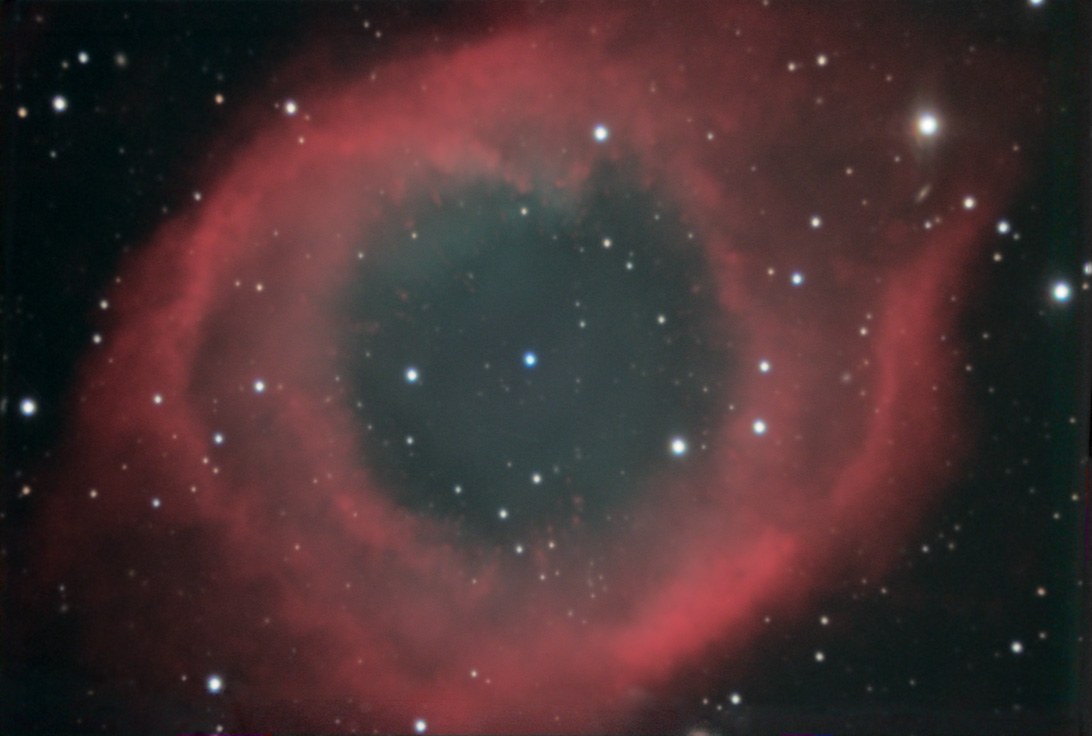NGC 7293
Helix Nebula

For high resolution, click here.
NGC 7293
Helix Nebula: The Helix Nebula in the constellation Aquarius is one of the closest planetary nebulae to Earth. It has a similar color and shape to the Ring and the Dumbbell Nebulae, and the central star is easily visible. Notice also that several galaxies can be seen through the thin layers of this nebula.
NGC: 7293
Right Ascension: 22h 29m
Declination: -20° 50'
Apparent Magnitude: 13.5
Date: November 2010
Equipment:
Telescope: Meade 16" Schmidt Cassegrain with f6.3 reducer (used at ~ f6.1)
Camera: SBIG ST-10XE
Guiding: PHD, DSI Pro, Meade 5"
Exposure: L: 35x3m, binned 1x1
RGB: 6x5m, binned 2x2
The camera was at -35°
Processing Notes: Data acquisition with CCDSoft. Reduced and aligned in CCDStack and combined with Sigma Combine. Log stretch import of L into Photoshop. Adjusted curves and levels. Increased contrast via a 50% highpass filter overlay layer. Slight blur on the dim areas and sharpening on non-star bright areas. Minimize filter on the stars. Repaired several edge areas. RGB combined in AstroArt at 1:1.05:1.8 ratio. Adjusted curves and levels, and reduced noise of RGB. L was combined with RGB using three layers: Luminance on the bottom; RGB as a multiply(30%) layer; and RGB as a color layer on top. Final adjustment and tweak in Photoshop.
Scale: .525"/pixel on highest resolution
Links to images of this object on other sites:
http://antwrp.gsfc.nasa.gov/apod/ap090303.html
http://antwrp.gsfc.nasa.gov/apod/ap070223.html
http://jthommes.com/Astro/Helix.htm
Additional Comments: Some of the luminosity for the image was taken in September 2010, but was not processed because appropriate dark frames were not available at the time. Data was taken on three separate nights, and the seeing varied greatly between nights.
A planetary nebula occurs when a sun-like star is reaching the end of its life. Typically, the star will have a core made of carbon, surrounded by a shell of helium (in the process of fusing into carbon), and outer layers of mostly Hydrogen. The fusing Helium will shrink and heat the core, attempting to fuse the carbon into heavier elements, but the temperature and pressure will never be great enough in a star of this (relatively low) mass to fuse the carbon. As a result, this very hot carbon core and helium shell drive off the outer layers of hydrogen. As these outer layers are driven off by the intense heat of the core, they form what is called a planetary nebula, that is visible as a shell of glowing gas surrounding a very hot central star. (Note that the term "planetary" has nothing to do with planets - they are called planetary because in early telescopes they appeared to be tiny fuzzy disks that reminded observers of planets!) Because the details of this shedding process can vary significantly from star to star, all planetary nebulae are unique, and many show multiple shells, as different layers are shed over a period of time. Eventually, the shell will dissipate and the hot core, now called a white dwarf, will remain. A white dwarf can have as much mass as the Sun, but compressed into a sphere the size of the Earth. For more information, try http://en.wikipedia.org/wiki/Planetary_nebula
Views: 11457
 This work is licensed under a Creative Commons Attribution-NonCommercial-ShareAlike 4.0 International License.
This work is licensed under a Creative Commons Attribution-NonCommercial-ShareAlike 4.0 International License.

